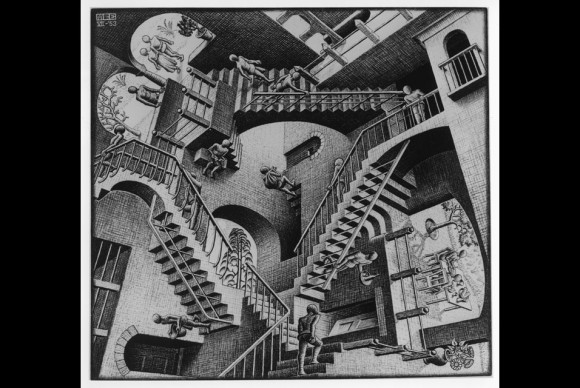Akron Art Museum, One of Only Two Venues in the U.S., to Host M.C. Escher: Impossible Realities
AKRON, OH.- You’ve seen the posters, now see the originals. As the last of only two venues in the United States to show this once-in-a-lifetime loan from Athens, Greece, M.C. Escher: Impossible Realities, on view at the Akron Art Museum February 12 – May 29, 2011, presents the rare and thrilling privilege of examining first-hand the masterworks of Maurits Cornelis Escher.
One of the most brilliant yet enigmatic artists of the 20th century, Escher delighted in creating visual puzzles that challenge our perception of reality.
“Are you really sure that a floor can’t also be a ceiling?” asked Escher. “Are you definitely convinced that you will be on a higher plane when you walk up a staircase?” Such musings led to “mind-bending” qualities in his spatial illusions and have lent his imagery an enduring place in pop culture iconography.
“We are so excited to offer viewers the chance to become enchanted with Escher’s unique vision of the world,” said Curator of Exhibitions Ellen Rudolph. “Spending time with his exquisitely executed prints will undoubtedly yield wonderful discoveries and, as Escher hoped to inspire in his viewers, pure astonishment.”
Impossible Realities provides the opportunity to survey the breadth of Escher’s career from the 1920s to the 1960s. The exhibition showcases 130 of the artist’s finest works, starting with his early book plates, moving on to landscapes, tessellations and impossible worlds, and concluding with his very last print, Snakes (1969). Featured in the exhibition are seminal and instantly recognizable works such as Drawing Hands and Reptiles, as well as the extremely rare lithographic stone for the making of Flatworms and wood blocks, study drawings and single-color prints that illustrate Escher’s artistic process from concept to finished print. The exhibition comes from the Herakleidon Museum in Athens, Greece, which houses one of the world’s largest collections of Escher’s work. The Akron Art Museum is one of only two U.S. venues for the exhibition.
Maurits Cornelis Escher (1898-1972) has been received varyingly over the last half-century by art critics and historians, mathematicians, scientists, crystallographers and educators. Regarded by some as an ingenious mathematician, Escher has also been critiqued within the art world as more of an intellectual than an artist.
Born in Leeuwarden, Holland, Escher was never an outstanding student. He began his university studies in architecture but quickly changed courses to pursue the graphic arts. Upon finishing school, Escher traveled throughout southern Europe, concentrating much time in Italy, where he was deeply inspired by the landscape and lived until 1937. His career as an artist began with landscapes derived from sketches he made while traveling.
Printmaking was Escher’s chosen medium. His pencil and ink drawings and sketches were merely a way to record what he saw during his travels or to work out spatial and structural relationships. Escher favored the woodcut, although he experimented widely with wood engravings, lithographs and mezzotints. Before carving his woodblocks, Escher spent weeks or even months working out each tiny detail of his compositions.
Decorative patterns that Escher encountered while traveling had a profound impact on his career, sparking a lifelong obsession with tessellations (repeating patterns that fill a plane). Majolica mosaics and stucco patterns at the Alhambra, a 14th century Moorish palace in Granada, Spain, enthralled him, as did cathedral decorations in Ravello, Italy, along the Amalfi coast. Tessellations figure prominently in Escher’s oeuvre, and his work with these patterns captivated mathematicians and crystallographers, who continue to use them to illustrate complex concepts and theories.
Escher left Italy in 1937 due to mounting discomfort with Mussolini’s Fascist regime. Less inspired by his surroundings in Brussels, Belgium and later Baarn, Holland, where he settled permanently, he began to turn inward for ideas, delving into the concepts of relativity, infinity and metamorphoses.
During his lifetime, Escher created a total of 448 lithographs, woodcuts and wood engravings, and over 2,000 drawings and sketches. The diverse offerings in Impossible Realities allow the viewer to chart the progression of Escher’s career, including early Italian landscapes, book illustrations, rare ink drawings, impossible worlds, tessellations, renderings of infinity and more. Included in the exhibition are three-dimensional models of two of Escher’s “impossible buildings” Belvedere and Waterfall. Viewers will be able to observe how these impossible constructions would exist in three dimensions—the elements only align in one location in space. There will also be an entrancing video animation of Print Gallery, a mind-bending spiral-form composition with a mysterious void in the center.
Related posts:
- Contemporary Chinese Paintings from the Allen Memorial Art Museum on View at the Akron Art Museum
- Audio-Visual Experience of the North Pole to Open at the Akron Art Museum
- Detroit Disassembled: Photographs by Andrew Moore at the Akron Art Museum
- “Uncanny Realities” Exhibition of Sculptures and Photographs at Museum Frieder Burda
- Morris Museum of Art to host “Deep Sea – Drawings by William O. Golding”

